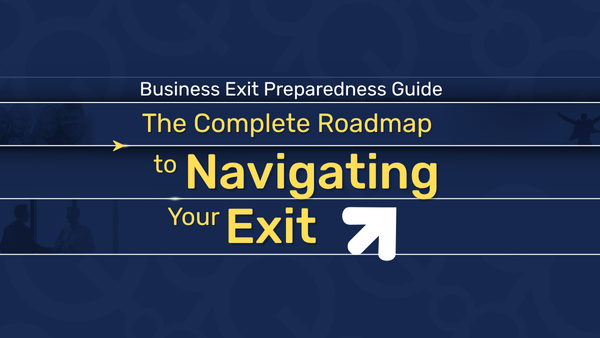When Financial Stress Becomes Strategic Opportunity

Financial distress strikes businesses with ruthless unpredictability. Cash flow crises, market disruptions, operational failures, or external shocks can transform a profitable enterprise into a struggling company seemingly overnight. For most business owners, financial stress feels like the end of exit opportunities. The reality is more nuanced, and potentially, more profitable.
While traditional exit planning assumes financial health and stability, distressed situations often create unique opportunities for strategic exits. Specialized acquirers with experience in turnaround situations understand the difference between temporary financial challenges and fundamental business problems. These sophisticated buyers frequently pay premiums for businesses with strong underlying assets experiencing fixable difficulties.
Research examining 166 potentially bankrupt UK firms found that recovery and non-recovery firms adopted very similar strategies, but recovery firms proved far more effective in strategy implementation. This suggests that distressed exits aren’t about having perfect solutions; they’re about execution excellence under pressure—exactly the type of capability that experienced strategic acquirers can provide.
The distressed M&A market has experienced significant growth, with 2023 seeing an uptick in distressed dealmaking despite overall M&A activity declining. This trend reflects the growing sophistication of strategic acquirers who can differentiate between distressed assets and distressed businesses, often transforming temporary challenges into long-term competitive advantages.
Understanding the Distressed Exit Landscape

What Defines a Distressed Exit
Distressed exits occur when companies experiencing financial instability, operational challenges, or market pressures seek buyers or restructuring partners. Unlike traditional M&A where healthy companies attract strategic or financial buyers, distressed transactions involve companies facing:
- Negative cash flow and liquidity constraints
- High debt levels relative to assets or earnings
- Declining revenues or market share
- Operational inefficiencies requiring significant restructuring
- Potential bankruptcy or insolvency proceedings
The Strategic Acquirer Advantage
Experienced Strategic Buyers: Companies with proven track records in acquiring and transforming distressed businesses. These acquirers understand how to identify fixable problems and can provide both capital and operational expertise to execute turnarounds effectively.
Operational Turnaround Capabilities: Strategic acquirers bring specialized knowledge in restructuring operations, optimizing cash flow, and implementing sustainable business improvements that restore profitability.
Integration Expertise: Sophisticated buyers can seamlessly integrate distressed acquisitions into existing operations, leveraging synergies and economies of scale that standalone turnaround efforts cannot achieve.
Capital Resources: Well-capitalized strategic acquirers can provide immediate liquidity to stabilize operations while implementing longer-term strategic improvements.
The Marvel Entertainment Playbook: From Bankruptcy to $4 Billion Exit

One of the most spectacular distressed turnarounds in business history demonstrates the potential value creation possible through strategic distressed investing. In the late 1990s, Marvel Entertainment was struggling financially and filed for bankruptcy. The company faced declining comic book sales, poor licensing deals, and operational inefficiencies.
A group of investors led by Isaac Perlmutter and Avi Arad, who owned Toy Biz and had licensing agreements with Marvel, recognized the underlying value in Marvel’s intellectual property. They acquired Marvel’s bonds at significant discounts and converted them into equity through a court-approved bankruptcy plan, gaining majority control.
The Turnaround Strategy
Asset Optimization: The investors focused on Marvel’s core strength – its extensive library of character intellectual property that had been undermonetized.
Operational Restructuring: They streamlined operations, cut unnecessary costs, and eliminated redundant business lines that weren’t contributing to core value.
Revenue Model Innovation: Marvel shifted from relying primarily on comic book sales to developing movies based on popular characters, creating new revenue streams.
Strategic Partnerships: The company expanded licensing deals and developed partnerships that maximized the value of its character portfolio.
The Result
Marvel emerged from bankruptcy in 1998 with its stock price rising to over $50 per share by 2009. The Walt Disney Company acquired Marvel for $4 billion in 2009, generating massive returns for the investors who rescued the company from financial distress. This represents one of the most successful distressed-to-exit transformations in modern business history.
Industry-Specific Distressed Exit Strategies

Technology and Software Companies
Intellectual Property Value: Focus on patents, proprietary technology, and software assets that retain value regardless of operational performance.
Customer Base Monetization: Existing customer relationships and recurring revenue streams often attract strategic buyers even when companies face financial stress.
Talent Acquisition: Technology companies in distress may attract buyers seeking to acquire skilled development teams and technical expertise.
Manufacturing and Industrial Businesses
Asset-Heavy Valuations: Manufacturing equipment, facilities, and production capabilities often have substantial standalone value attractive to strategic buyers.
Supply Chain Integration: Distressed manufacturers may offer vertical integration opportunities for buyers seeking to control supply chains.
Market Share Consolidation: Industry consolidation opportunities allow competitors to acquire market share and eliminate capacity during downturns.
Retail and Consumer Businesses
Brand Value Preservation: Strong consumer brands retain value even during financial distress, attracting buyers who can revitalize operations.
Location Assets: Prime retail locations, distribution centers, and customer traffic patterns provide value beyond current operational performance.
Inventory Liquidation: Well-managed inventory clearance can generate immediate cash flow while preserving core business operations.
Service Businesses
Customer Relationship Transfer: Professional service firms offer valuable client relationships that can be integrated into larger organizations.
Human Capital: Skilled professionals and established teams often motivate acqui-hire transactions focused on talent acquisition.
Process and System Value: Established operational processes, systems, and methodologies may provide value to strategic buyers.
Navigating Distressed M&A Process Complexities

Why Strategic Acquirer Experience Matters
The complexity of distressed M&A requires specialized expertise that only comes from extensive experience in turnaround situations. Strategic acquirers with proven track records bring invaluable advantages that can mean the difference between successful transformation and continued decline.
Process Expertise: Experienced strategic acquirers understand the compressed timelines, stakeholder complexities, and regulatory requirements unique to distressed transactions. This expertise accelerates deal completion and reduces execution risk.
Operational Knowledge: Strategic acquirers with industry experience can quickly identify the operational changes needed to restore profitability, implement proven improvement methodologies, and avoid common turnaround mistakes.
Relationship Management: Experienced acquirers know how to manage complex stakeholder relationships including creditors, employees, customers, and regulatory authorities throughout the acquisition and integration process.
Integration Capabilities: Strategic acquirers with established integration processes can rapidly incorporate acquired companies into existing operations, realizing synergies and operational improvements faster than inexperienced buyers.
Capital Resources: Well-established strategic acquirers can provide immediate capital injection and ongoing financial support needed to stabilize operations and fund necessary improvements.
The Strategic Acquirer Partnership Advantage

The Integration Excellence Factor
The success of distressed acquisitions often depends more on integration excellence than on the initial transaction structure. Strategic acquirers with proven integration capabilities can rapidly implement improvements while maintaining business continuity.
Systematic Integration Processes: Experienced strategic acquirers have developed proven methodologies for integrating distressed acquisitions, reducing execution risk and accelerating time to value.
Cultural Preservation: Skilled acquirers know how to preserve valuable aspects of company culture while implementing necessary changes, maintaining employee morale and customer relationships.
Technology and Systems Integration: Strategic acquirers can quickly integrate technology systems and operational processes, eliminating redundancies and improving efficiency.
Knowledge Transfer: Experienced acquirers facilitate bidirectional knowledge transfer, combining the acquired company’s market expertise with the acquirer’s operational capabilities.
Common Distressed Exit Mistakes and How to Avoid Them

The Delay Trap
Mistake: Waiting too long to recognize financial distress and begin restructuring efforts, allowing problems to compound and reduce options.
Solution: Implement early warning systems that identify financial stress before it becomes crisis, providing more time and options for strategic response.
The Cost-Cutting Obsession
Mistake: Focusing exclusively on cost reduction without addressing underlying strategic problems or revenue generation capabilities.
Solution: Balance immediate cost management with investments in core capabilities necessary for long-term viability and buyer attractiveness.
The Stakeholder Neglect
Mistake: Failing to communicate effectively with creditors, employees, customers, and other stakeholders, leading to lost support during critical periods.
Solution: Develop comprehensive stakeholder communication strategies that maintain relationships while managing expectations realistically.
The Undervaluation Acceptance
Mistake: Accepting the first offer from distressed buyers without exploring alternative structures or buyers who might offer better terms.
Solution: Even in distressed situations, competitive processes can generate better outcomes by attracting multiple potential buyers.
Building Antifragile Operations Before Crisis Hits

Building Strategic Relationships Before Crisis
Smart business owners don’t wait for financial distress to develop relationships with strategic acquirers. Building these connections during healthy periods creates valuable optionality when challenging times arise.
Industry Engagement: Participate in industry events and conferences where strategic acquirers are active, building relationships and understanding their acquisition criteria and capabilities.
Performance Visibility: Maintain visibility of your company’s performance and capabilities within your industry, ensuring strategic acquirers are aware of your business value proposition.
Strategic Dialogue: Engage in strategic conversations with potential acquirers about industry trends, challenges, and opportunities, building mutual understanding and respect.
Professional Networks: Develop relationships with intermediaries and advisors who work regularly with strategic acquirers, creating pathways for future engagement.
Preparing for Strategic Partnership
Operational Excellence: Maintain strong operational performance and detailed documentation that demonstrates your company’s underlying value and potential.
Financial Transparency: Implement robust financial reporting and forecasting systems that enable rapid due diligence and decision-making during distressed periods.
Strategic Positioning: Clearly articulate your company’s strategic value proposition and competitive advantages that would interest strategic acquirers.
Team Development: Build management capabilities and operational expertise that strategic acquirers would want to retain and integrate into their organizations.
The Future of Distressed M&A

Market Trends Driving Opportunity
Economic Uncertainty: Continued economic volatility creates ongoing distressed opportunities across industries and geographic markets.
Industry Disruption: Technological change and market evolution create winners and losers, with distressed situations emerging in disrupted sectors.
Capital Market Conditions: Tightening credit markets and higher interest rates increase financial stress for leveraged companies.
Regulatory Changes: Evolving regulations create compliance costs and operational challenges that can trigger financial distress.
Buyer Evolution
Sophisticated Processes: Distressed buyers are developing more sophisticated evaluation and transaction processes, creating opportunities for well-prepared sellers.
Industry Specialization: Specialized turnaround funds and strategic buyers are focusing on specific industries, increasing competition for quality distressed assets.
Technology Integration: Advanced analytics and technology are improving distressed investment decision-making and operational improvement capabilities.
ESG Considerations: Environmental, social, and governance factors are becoming more important in distressed investment decisions.
The Strategic Partnership Advantage

Building Strategic Acquirer Relationships (For Healthy Businesses)
- Industry Intelligence: Research and identify strategic acquirers active in your industry with proven track records in turnaround situations
- Relationship Development: Engage with strategic acquirers through industry events, professional networks, and strategic conversations
- Performance Documentation: Maintain detailed operational and financial records that demonstrate your company’s strategic value
- Strategic Positioning: Clearly articulate your competitive advantages and strategic fit with potential acquirers
Engaging Strategic Acquirers (During Distress)
- Rapid Assessment: Quickly identify which strategic acquirers have the experience and resources to execute successful distressed acquisitions
- Partnership Approach: Frame discussions as strategic partnerships rather than distressed sales, emphasizing mutual value creation opportunities
- Integration Planning: Work collaboratively with strategic acquirers to develop integration plans that preserve value while enabling improvements
- Stakeholder Alignment: Leverage the strategic acquirer’s experience to align diverse stakeholder interests and expedite transaction completion
Distressed Doesn't Mean Devalued

Financial distress doesn’t eliminate exit opportunities; it reveals them to strategic acquirers with the experience and resources to unlock hidden value. While traditional buyers may retreat during company stress periods, experienced strategic acquirers often increase activity, recognizing opportunities to acquire quality businesses and create transformational value through expert intervention.
The most successful distressed exits combine rapid operational improvement with strategic partnership approaches that leverage the acquirer’s capabilities and resources. Companies that can work collaboratively with experienced strategic acquirers often achieve better outcomes than would be possible through standalone turnaround efforts or transactions with less experienced buyers.
At 9Q Exit Holdings, we bring extensive experience in acquiring and transforming distressed businesses across multiple industries. Our proven track record includes successful partnerships with companies facing various forms of financial stress, operational challenges, and market disruption. We understand that behind every distressed situation is a business with underlying value waiting to be unlocked through strategic partnership and expert execution.
Contact us to explore how our experience in complex acquisitions can transform your challenging situation into a strategic opportunity for long-term success.







